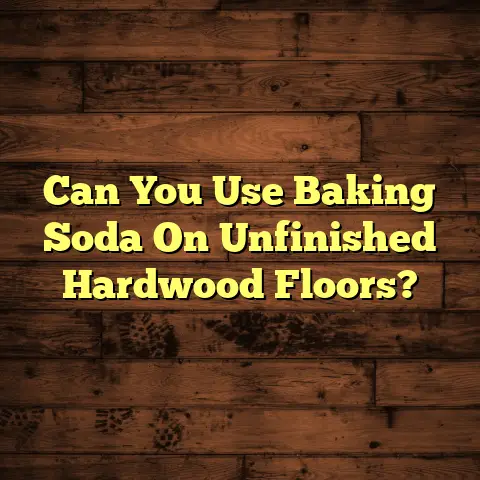Keep Floors Dry! (3 Leaks = Floor Rot!)
Would you rather live in a beautiful home with stunning hardwood floors, or in a damp house with moldy carpets?
The answer seems obvious, yet many homeowners unknowingly put their dream floors at risk every day due to hidden leaks and moisture issues.
As a flooring contractor with years of experience, I’ve seen firsthand the devastating effects of water damage on homes.
It’s not pretty, and it’s definitely something you want to avoid.
That’s why I’m here to walk you through everything you need to know about keeping your floors dry and preventing floor rot.
Section 1: Understanding the Importance of Floor Maintenance
1. The Foundation of Your Home
Flooring isn’t just about aesthetics; it’s a critical component of your home’s structure and overall appeal.
Think about it: your floors are what you walk on every day.
They support your furniture, your family, and basically everything inside your house.
Proper flooring maintenance isn’t just about keeping things looking nice.
It significantly contributes to your property value and, more importantly, your safety.
A well-maintained floor prevents trips and falls, protects against mold growth, and ensures the structural integrity of your home.
2. Common Flooring Materials
Let’s talk about the different types of flooring out there and how they react to moisture.
-
Hardwood: Beautiful, classic, but oh-so-vulnerable to water.
It can warp, cup, and rot if exposed to moisture for too long. * Laminate: A cheaper alternative to hardwood, but still susceptible to water damage.
It can swell and delaminate if water seeps in. * Tile: Generally water-resistant, especially ceramic and porcelain.
However, the grout between tiles can be porous and allow water to seep through, leading to problems underneath. * Carpet: A moisture magnet! It absorbs water like a sponge, creating the perfect breeding ground for mold and mildew. * Vinyl: Waterproof, making it a great option for bathrooms and kitchens.
However, water can still get trapped underneath if not properly installed.
Each flooring type has its own vulnerabilities.
Knowing what you’re dealing with is the first step in protecting your floors.
Section 2: The Dangers of Moisture and Water Leaks
1. What Causes Floor Rot?
Floor rot, in simple terms, is the decay of wood caused by fungi.
These fungi thrive in damp environments, feeding on the wood and weakening its structure.
The implications for homeowners are significant.
Floor rot can lead to:
- Weakened floors that sag or collapse
- Unpleasant odors
- Mold growth
- Costly repairs
Moisture is the key ingredient in this recipe for disaster.
Without it, the fungi can’t survive, and your floors are safe.
2. How Water Intrusion Occurs
So, how does water get where it shouldn’t be?
Here are some common culprits I’ve seen over the years:
-
Plumbing Issues: Leaky pipes under sinks, behind toilets, or in walls are a major source of water damage.
Even a small, slow drip can cause significant damage over time. * Roof Leaks: A damaged or poorly maintained roof can allow rainwater to seep into your attic and down into your walls and floors. * Basement Flooding: Basements are notorious for moisture problems, especially if they’re not properly waterproofed.
Groundwater can seep through cracks in the foundation, leading to flooding. * Appliance Leaks: Washing machines, dishwashers, and refrigerators can all leak, causing water damage to nearby floors. * Environmental Factors: Climate and humidity play a big role.
In humid climates, moisture can condense on cool surfaces, leading to mold growth.
Heavy rainfall or snowmelt can also overwhelm drainage systems and lead to flooding.
Section 3: The Leak-to-Rot Connection
1. The Three Leak Rule
I call it the “Three Leak Rule,” and it’s something I’ve observed time and time again in my work.
One leak might seem like a minor inconvenience, but three leaks?
That’s when things can quickly spiral out of control and lead to irreversible damage and rot.
Why three?
Well, it’s not a hard and fast number, but it represents a tipping point.
Multiple leaks mean:
- Increased moisture levels: More water means a higher chance of fungal growth.
- Wider spread of damage: Water can travel through walls and floors, affecting a larger area.
- Delayed detection: You might fix one leak and think you’re done, only to have another one pop up, delaying your response and allowing the damage to worsen.
Let me give you a real-life scenario:
I once worked on a house where the homeowner had a small leak under the kitchen sink, a leaky toilet in the guest bathroom, and a minor roof leak near the chimney.
Individually, none of these seemed like a huge deal.
But together, they created a perfect storm of moisture that led to extensive floor rot in the kitchen and hallway.
The homeowner ended up having to replace a large section of the subfloor, costing them thousands of dollars.
2. Signs of Water Damage
Being vigilant about the warning signs of water damage is crucial.
Here are some things to look out for:
-
Stains: Water stains on ceilings, walls, or floors are a dead giveaway.
They can range in color from yellow to brown and often have a musty odor. * Warping: Wood floors can warp or buckle when exposed to moisture.
This is especially noticeable near walls and doorways. * Mold: Mold can grow in a variety of colors, including black, green, and white.
It often has a fuzzy or slimy texture and a distinctive musty smell. * Peeling Paint or Wallpaper: Moisture can cause paint to peel and wallpaper to bubble. * Musty Odors: A persistent musty odor is a strong indicator of mold or mildew growth, even if you can’t see it. * Soft Spots: If you step on a floorboard and it feels soft or spongy, it’s likely that the wood has rotted. * Visible Mold Growth: Obvious, but sometimes it’s hidden. Check dark, damp areas like under sinks and in corners.
Anecdote: I had a client who ignored a small water stain on their ceiling for months, thinking it was just a cosmetic issue.
Turns out, it was a slow roof leak that had been dripping into the attic for quite some time.
By the time they called me, the damage was extensive, and they had to replace a large section of the roof and ceiling.
Section 4: The Consequences of Ignoring Leaks
1. Health Risks
Ignoring leaks and allowing mold and mildew to grow can have serious health implications.
Mold can trigger allergic reactions, asthma attacks, and other respiratory problems.
According to the Environmental Protection Agency (EPA), mold exposure can cause:
- Nasal stuffiness
- Eye irritation
- Wheezing
- Skin irritation
People with allergies, asthma, or weakened immune systems are particularly vulnerable to the health effects of mold.
It’s not just about the flooring; it’s about the well-being of everyone living in the house.
2. Financial Impact
Let’s talk about the financial consequences of ignoring leaks.
It’s not just the cost of repairing or replacing the damaged flooring.
It’s also the potential for:
- Higher insurance premiums: Filing a water damage claim can increase your insurance rates.
- Decreased property value: Water damage can significantly lower the value of your home.
- Costly repairs: The longer you wait to address a leak, the more extensive the damage will be, and the more it will cost to fix.
- Health-related expenses: Medical bills and lost productivity due to mold-related illnesses can add up quickly.
According to HomeAdvisor, the average cost to repair water damage is between \$2,500 and \$7,500.
However, the cost can be much higher depending on the extent of the damage.
Expert Quote: “Water damage is one of the most common and costly homeowner insurance claims,” says Loretta Worters, a spokesperson for the Insurance Information Institute.
“Addressing leaks promptly can save homeowners thousands of dollars in the long run.”
Section 5: Preventive Measures and Maintenance Tips
1. Regular Inspections
Regular inspections are key to catching leaks early before they cause significant damage.
I recommend checking the following areas at least twice a year:
- Under Sinks: Look for signs of leaks around pipes and faucets.
- Around Toilets: Check for leaks around the base of the toilet and the supply line.
- Basements: Inspect the walls and floors for cracks and signs of moisture.
- Attics: Look for signs of roof leaks, such as water stains or mold.
- Around Appliances: Check for leaks around washing machines, dishwashers, and refrigerators.
- Windows and Doors: Inspect the seals around windows and doors for gaps or cracks.
What to Look For:
- Water stains
- Mold or mildew
- Peeling paint or wallpaper
- Musty odors
- Soft spots
How Often to Inspect:
- Twice a year (spring and fall)
- After heavy rain or snow
2. Waterproofing Solutions
There are several waterproofing methods and products available to protect your floors from moisture:
- Sealants: Apply sealant to grout lines in tiled areas to prevent water from seeping through.
- Waterproof Membranes: Install a waterproof membrane under tile or laminate flooring in bathrooms and kitchens.
- Vapor Barriers: Use a vapor barrier under wood floors to prevent moisture from rising from the subfloor.
- Dehumidifiers: Use a dehumidifier in basements and other damp areas to reduce moisture levels.
- Sump Pumps: Install a sump pump in basements to remove excess water.
- Proper Ventilation: Ensure that bathrooms and kitchens are properly ventilated to remove moisture.
Benefits and Considerations:
Each method has its own benefits and considerations.
Sealants are relatively inexpensive and easy to apply, but they need to be reapplied periodically.
Waterproof membranes provide excellent protection but can be more expensive to install.
Vapor barriers are essential for wood floors but can trap moisture if not installed correctly.
Dehumidifiers can be effective at reducing moisture levels, but they require regular maintenance.
3. Emergency Response to Leaks
If you detect a leak, it’s important to act quickly to minimize damage.
Here’s a step-by-step guide on what to do:
- Stop the Source: If possible, turn off the water supply to the leaking fixture or appliance.
- Contain the Water: Use towels, buckets, or plastic sheeting to contain the water and prevent it from spreading.
- Remove Excess Water: Use a wet/dry vacuum to remove standing water.
- Dry the Area: Use fans and dehumidifiers to dry the affected area as quickly as possible.
- Contact a Professional: Call a qualified plumber or water damage restoration company to assess the damage and make repairs.
- Document the Damage: Take photos and videos of the damage for insurance purposes.
Importance of Quick Action:
The longer you wait to address a leak, the more damage it will cause.
Mold can start to grow within 24-48 hours, so it’s important to dry the area as quickly as possible.
Section 6: Case Studies and Real-Life Examples
1. Success Stories
I’ve seen homeowners successfully prevent floor rot by taking proactive measures.
One client of mine diligently inspected their home for leaks every spring and fall.
They caught a small roof leak early on and were able to repair it before it caused any significant damage.
They also installed a dehumidifier in their basement to keep moisture levels low.
As a result, their floors remained dry and rot-free for years.
Testimonial: “I’m so glad I took the time to inspect my home regularly,” says the client.
“It saved me a lot of money and headaches in the long run.”
2. Cautionary Tales
Unfortunately, I’ve also seen homeowners face severe consequences due to ignored leaks.
Another client ignored a persistent musty odor in their bathroom for months, thinking it was just a ventilation issue.
Turns out, there was a hidden leak behind the shower wall that had been causing mold to grow.
By the time they called me, the mold had spread throughout the bathroom and into the adjacent hallway.
They had to gut the entire bathroom and replace a large section of the hallway flooring, costing them tens of thousands of dollars.
Lessons Learned:
- Don’t ignore musty odors or other signs of water damage.
- Address leaks promptly before they cause significant damage.
- Regular inspections are key to catching leaks early.
Section 7: Conclusion
Keeping your floors dry is essential to prevent floor rot and protect your home from costly damage.
By understanding the dangers of moisture, taking preventive measures, and acting quickly when leaks occur, you can safeguard your floors and ensure the well-being of your family.
Don’t wait until it’s too late.
Start inspecting your home for leaks today and take the necessary steps to keep your floors dry.
Your home (and your wallet) will thank you for it.





